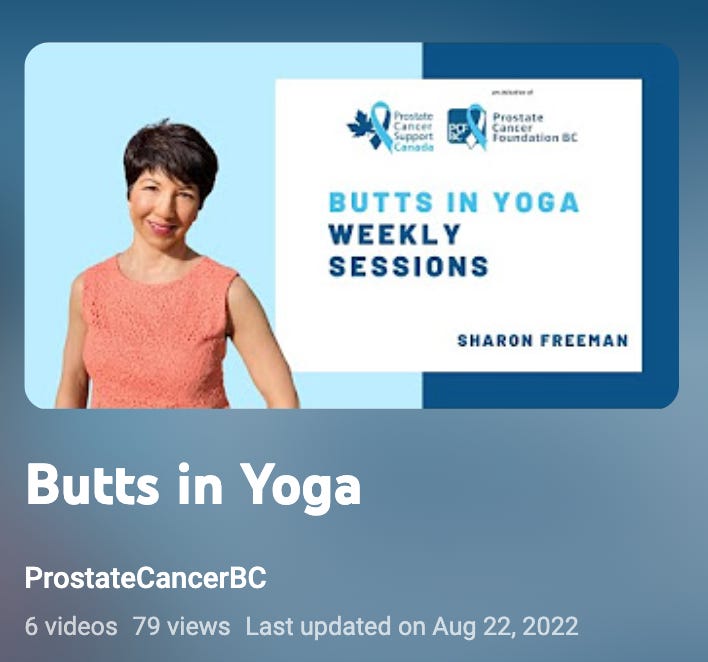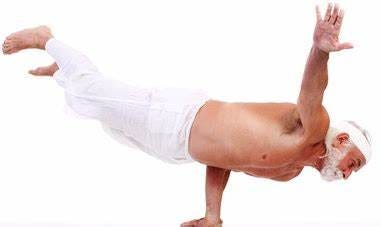2023 New Year's resolution: Yoga ASanas (poses) for very active surveillors
Zooming with the yogis and streaming with qigong
By Howard Wolinsky
Throughout the pandemic, I have maintained “forest therapy.” I try to walk five to seven miles in the woods near my home outside Chicago.
It clears my cobwebs and keeps my butt in motion..
But I have fallen down on other activities that were part of my pre-pandemic routine. Specifically, yoga and qigong. I used to go to the gym daily and do some asanas (yoga poses), such as the Boat, the Cobra, the Warrior, and the Corpse, to try to maintain flexibility and balance. I also dropped qigong (see more further down).
That went out the window when I quit going to the gym. It didn’t have to. But it did.
So when I heard that Prostate Cancer Support Canada/Prostate Cancer British Columbia had a virtual yoga class for prostate cancer patients, I thought I’d drop in.
The yoga program is part of the support group’s series of “Butts in Motion” activities to keep prostate cancer patients moving. There have Blue Walkers Clubs, Butts on Bikes, Butts on Boats, and the like.
But what does yoga have to do with prostate cancer?
Meyer Quaynor, of the Canadian group, explained what the yoga classes are about: “They are prostate cancer-safe, rather than prostate cancer-specific. However, there is a lot of focus on strengthening the pelvic floor because our instructor knows the audience.”
Lots of good reasons for strong pelvic floors, following surgery or not.
The instructor is Sharon Freeman, perky and flexible, just what you want in a yoga teacher. She has been a fitness enthusiast since she was a kid and a fitness instructor for more than 20 years.
It’s paid off for her: “I no longer have a potentially life-threatening, supposedly incurable, autoimmune condition known as Takayasu’s Arteritis thanks to fitness and healthy mindset.” she said.
(Sharon Freeman, Butts in Yoga.)
Sharon keeps the students moving with asanas, such as the Warrior, Cat-Cow, Corpse, etc. It’s a good hour-long workout.
If you have an interest in yoga, join Sharon’s free class at 6 p.m. Eastern on Tuesdays. Sign up here. Meanwhile, you can view some of Sharon’s previous classes at the YouTube channel: https://bit.ly/3Z8GPH3
I am not exactly a newcomer to yoga, I have been a “practitioner,” albeit a half-hearted one, for 50+ years,
Back in 1971, my wife Judi and I, decked out in our workout clothes, went to a gym in a state mental hospital in Kankakee, Illinois, outside Chicago. (I was a newspaper reporter, fresh out of college, and she was an elementary school teacher.)
The bemused guard asked, “Here for the yogurt class?”
Yogurt was a hot topic in those days. We got at least three yogurt makers as wedding gifts. It’s just natural to get yogurt confused with yoga, I guess.
But no, we were there for a yoga class with Ghita, a tiny, young woman, who learned yoga as a girl in India. She approached yoga with ferocity as if it were an Olympic sport.
It was an amazing experience. I’ve never been flexible. I couldn’t touch my toes. I still can’t.
But I found I could do yoga poses I never thought were possible. Like the Lotus, where you’re seated and your legs wrap around each other like a pretzel. The cross-legged full lotus was a challenge for the 20-something me. It took a while, but I eventually could do it.
(Unfortunately, I was showing off my lotus at a party and wracked up my knees because I didn’t warm up. Rule #1: Don’t force a Lotus. Rule #2: Maybe avoid the full Lotus.)
(More like it—partial lotus.)
I don’t pretend that I became a heavy-duty, lifelong yoga chela, or disciple. But I still practiced a few yoga poses when I could and plan to step it up such activities in 2023. I am trying to stretch, relax, and improve my balance.
(Super Yoga Senior: Don’t try this at home.)
So what’s this have to do with prostate cancer?
Yoga can be your friend. It can help you relax. Lift the stresses of anxious surveillance or anything else. It can improve your flexibility, balance, and strength as you age.
I joined Sharon’s class. I got down on my mat. I wasn’t sure I could get up again. I was very rusty, But I could approximate some of what the yogi demonstrated. And I did manage to get back up. Mission accomplished.
If you are inflexible or have trouble standing for long periods, there are chair yoga classes online and maybe at a community center near you, that can accomplish what traditional yoga classes do.
(Maybe chair yoga is more your speed.)
Yoga can improve your circulation, but yoga is not considered a cardio workout. It’s good for the heart in some ways, if you’re into chakras, energy points, but it’s not a boost to the cardiovascular system.
Remember: If you have prostate cancer, a heart attack is far more likely to kill you than prostate cancer. So get those aerobic exercises in. Also, do weight training.
Meanwhile, I ran across an article on yoga and prostate cancer.
The Times of India presents six poses that it claims can help prevent prostate cancer, balance hormones, etc. Maybe. They won’t hurt anyway—unless you don’t warm up or stretch yourself beyond what’s natural for you—and maybe they can help.
Don’t believe the BS in the article about urinary problems causing prostate cancer.
Maybe, this will get you in a yoga frame of mind in 2023.
After a yoga workout, generally, there is relaxation in the Corpse pose to relax and meditate. I sometimes think that’s the best part.
As they say at the end of yoga classes: Namaste. Gotta go.
Another option: The Qigong (Chi Gong) Show
Get your chi and mojo moving
By Howard Wolinsky
I have kept my resolution on one thing.
With wife Judi, I resumed my qigong practice. This ancient Chinese system gets your life force (chi) flowing and is a practical way of enhancing the flexibility and range of motion of your joints.
The Chinese claim this system has medical benefits, such as cancer cures. I’d be skeptical of that. But who knows?
Qigong is a mind-body-spirit practice that improves one's mental and physical health by integrating posture, movement, breathing technique, self-massage, sound, and focused intent.
It’s like yoga without getting on the floor. It’s a standing meditation practice.
Judi and I follow the Lift Chi Up, Pour Chi Down Method with Master Luke Chan. It’s called Chi-Lel Qigong.
Chan‘s accent can initially be difficult. He uses a lot of unfamiliar Chinese terms. Don’t be discouraged. You can easily follow the 20-minute program without understanding what the words mean.
Here’s a cheat sheet:
Don’t worry if you can’t touch your toes. Do the best you can. You’ll improve over time.
Go with the flow:
Here’s a free online version of Chan in action:
For more on Chi-Lel and Chan go to:
https://www.lukechanchilel.com/
Qigong is a warm-up that can be a standalone for another discipline, Tai Chi.
Check out Tai Chi with my pal active surveillor Allan Greenberg:
AS 101 Episode 3: A prostate cancer diagnosis with the father of AS
By Howard Wolinsky
When we last saw Larry White in Episode 2 of the video cliffhanger, Active Surveillance 101, he and his wife Nancy were coping with his rising PSA.
Dr. Laurence Klotz, “the father of AS, advised them about Larry’s options. Now on to Episode 3: The Whites meet again with Klotz about what’s next up for Larry regarding AS.
AS 101 is a series of 20-30-minute conversations between the Whites and leading prostate cancer experts covering essential questions for patients considering AS.
The goal of this series is to reach AS candidates, including the newly diagnosed and those who have not yet been diagnosed with prostate cancer but have rising PSAs (prostate-specific antigen) blood levels, to provide them with an introduction to AS.
Active Surveillance Patients International (ASPI) will premier the AS 101 Episode 3 video on Saturday, Jan. 28, 2023, at 12 p.m. Eastern. Register here: https://bit.ly/3ZeATME Don’t forget to bring some popcorn and Junior Mints.
The session will be followed by a Q&A, a discussion of the video, and a support session.
In 2022, ASPI honored Klotz, of the University of Toronto, as the first recipient of the Gerald Chodak Active Surveillance Pioneer Award. The late Dr. Chodak was Klotz’s mentor and also was ASPI’s first medical advisor.
The Active Surveillance Coalition (ASC) created the series called Active Surveillance 101 to teach the basics of AS to the newly diagnosed patients and to those in the “gray zone” with rising PSAs who are awaiting biopsies. Programs are brief, lasting 20-30 minutes without slides.
For the earlier videos go to: https://aspatients.org/a-s-101/.
At least four more programs are being developed, including one on biopsies and pathology reports with Dr. Jonathan Epstein, the top-gun pathologist on prostate cancer from Johns Hopkins University. Others deal with genetic and genomic testing and imaging, including MRIs and micro-ultrasounds..
AS 101 was created under the banner of the Active Surveillance Coalition, whose members include ASPI, AnCan’s Virtual Support Group for Active Surveillance, Prostate Cancer Support Canada, Prostate Cancer Research Institute, and The Active Surveillor newsletter.
Are invaders still snatching prostates?
By Howard Wolinsky
Don’t miss the AnCan webinar that will answer the question posed in the headline.
The program at 8-9:30 p.m. Eastern Jan. 30 features Dr. Mark C. Scholz, co-author of the groundbreaking 2010 book: “The Invasion of The Prostate Snatchers.”
Scholz’s program is entitled, "Invasion of the Prostate Snatchers: 13 years later. An evening with Dr. Mark Scholz." To register, click here.
Spoiler alert: Things are better, but the invaders still are snatching and nuking large numbers of prostates unnecessarily.










